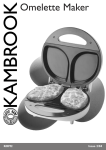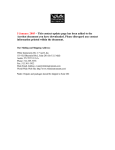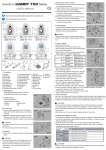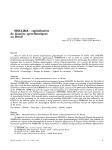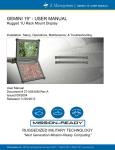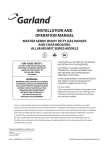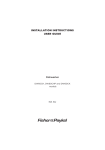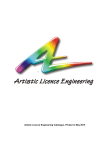Download User Manual
Transcript
FIELD-READY COMMAND CONSOLE 17&17ZS/VP User Manual Z Microsystems Regulatory FCC INFORMATION 1. Use the power and video cables supplied with the Command Console to help prevent interference with radio and television reception. The use of cables and adapters may cause interference with electronic equipment in the vicinity of this unit. Command C o ns ole 17 & 17zs/vp 3. Operation of this equipment in a residential area is likely to cause interference in which case the user will be required to correct the interference at his own expense. Changes or modifications not expressly approved by Z Microsystems could void user’s authority to operate the equipment 2. This equipment has been tested and found to comply with the limits for Class “A” digital devices, pursuant to certain 2 Issued 10/99 Doc# 27-0003UM Rev. 1.4 10/02 limits imposed by Part 15 of the FCC rules. These limits are designed to provide reasonable protection against harmful interference in when equipment is operated in commercial environments. This equipment generates, uses and can radiate radio frequency energy, and, if not installed and used in accordance with the instruction manual, may cause harmful interference to radio communications. Index Starting Point Shipment Contents User Manual System Requirements Product Description Tools Required Precautions 3 3 3 3 4 5 5 Trouble shooting 30 Specifications 31 Maintenance 33 Drawings 34 Install Rails Slide Removal Install Slides In Cabinet Frame 6 6 6 Hardware Install 36 Install Console Install Console In Slides Test Installation Final Adjustments 8 8 8 9 Warranty Standard Warranty FAQ’s 37 37 39 Setup Setting Up Monitor Keyboard And Mouse Closing Console 10 10 10 11 Support Further Help Replacing Parts Providing Feedback 40 40 41 41 OPERATION MODEL 17 Connecting Cables Powering Up 13 14 14 Monitor Adjustments Plug And Play Auto Adjustment Controls Automatic Save Direct-Access Features OSM Lock/Unlock Accessing Menu System Power Saver 15 15 15 16 17 18 19 19 22 OPERATION MODEL 17 zs/vp Connectors - Rear Panel 23 24 Monitor Adjustments Controls On-Screen Menu Accessing Menu System Menu Adjustment 25 25 27 27 28 3 Starting Point SHIPMENT CONTENTS USER MANUAL The Command Console shipping box contains the following: The User Manual comes in two formats: printed hardcopy or CDROM. This Manual is also available on the Z Microsystems web site (www.zmicro.com/manuals.htm). • The Command Console Unit • Video Signal Cable • AC Power Cable • User Manual Remember to save your original shipping container and packing material to transport or ship the Command Console. We recommend you read this manual as follows: Carefully follow the instructions in the Installation and Testing chapter for hookup and initial control settings. Refer to the Operation chapter for a complete description of all the user controls, and the Maintenance and Troubleshooting chapters for care and correcting any unforeseen problems with the system. SYSTEM REQUIREMENTS The Command Console works with any computer system that provides industry standard screen formats from 640 x 480 to 1280 x 1024, with up to 75 Hz vertical sync. Required input power is 90 - 264 VAC @47440Hz with a power consumption of 80Watts. 4 Issued 10/99 Doc# 27-0003UM Rev. 1.4 10/02 Starting Point PRODUCT DESCRIPTION The Command Console provides a liquid crystal display, a desk work surface and storage for any size keyboard and mouse in a 3.5" high (2U) standard 19" rack or transit case. The lightweight and durable aluminum construction provides exceptional strength in field applications. The high quality LCD screen provides full color and features up to 1280 x 1024 pixel resolution. Specially designed locks on each side of the Command Console hold the compact folded unit securely in place during storage. It can be easily adjusted to various vertical-viewing angles. The display works effectively with any workstation. Release of the two Z-Locks on the front sides of the Console allow it to slide out and the LCD display to quickly swing up into a reading position An electrostatically-applied and bakedon finish is used for extreme durability for shipboard, airborne, field deployments, and industrial or lab applications where weight and size are very critical. By lifting up the desktop, the keyboard and mouse can be easily removed and set on top. 5 Starting Point TOOLS REQUIRED Required Tools and Equipment Flathead screwdriver with about 10" shaft. Phillips screwdriver with about 10" shaft. DANGER: To avoid shock hazard: • Do not remove the covers around the Command Console. • Do not connect or disconnect the Command Console during an electrical storm. • The power cord plug must be connected to a properly wired and grounded power outlet. • Any equipment to which the Command Console will be attached must also be connected to properly wired and grounded power outlets. NOTE: For the fastest and easiest installation of the Command Console, follow these steps in the sequence they are presented. PRECAUTIONS In preparation to install the Command Console, take the following precautionary step: Turn off the electrical power to your computer. 6 Issued 10/99 Doc# 27-0003UM Rev. 1.4 10/02 Install Rails SLIDE REMOVAL With the Console sitting on a workbench with the front facing towards you, press down to release the Z-Locks on each side of the front of the Console to slide the side rails back. The slide rail will reach a stop about half way back. This is a safety stop to prevent the Console sliding out too far while mounted to the rack. Simultaneously press in the safety catches on each slide rail and slide the side rails all the way off the back of the Console. The slides should now be separated from the Console. Each slide unit includes the slide rail, with the front Z-lock mount and the rear mount. INSTALL THE SLIDES IN THE CABINET FRAME On the front of the cabinet frame, use three Phillips screws ((V) see page 36 - Install hardware ) on each side to secure the right and left Z-Lock mounts. On the rear of the cabinet frame, use three Phillips screws ((W) see page 36 - Install hardware) to loosely secure the right and left rear slide mount to the cabinet frame. DO NOT tighten these screws to allow for adjustment of the Console within the cabinet frame. DO NOT tighten these screws fully at this time. 7 On the slide rails, using a slot screwdriver, loosen off the slide extension rail screw ((U) see page 36 - Install hardware ). Repeat on each side. Install Rails Go back on the rear of the cabinet frame, and fully tighten the three Phillips screws ((W) see page 36 - Install hardware) holding the slide extension rail to the cabinet frame. Make sure you hold the slide mounts hard against the rack rail. 8 Issued 10/99 Doc# 27-0003UM Rev. 1.4 10/02 Install Console INSTALL THE COMMAND CONSOLE IN THE SLIDES Pull the two Console slides out until they lock. Hold the Console by each side, with the front toward you. Feed the four cables coming out of the Console back through the cabinet frame. Simultaneously press in the catches on each slide and slide the Console all the way into the cabinet frame. The Console should slide in and out easily. Guide the Console into the slides and slide the Console in until it stops. TEST INSTALLATION AND MAKE ADJUSTMENTS Slide the Console in and out several times. The Console should easily close completely. Because of variances in cabinet frames, there may need to be some adjustments of the Console slide system for best fit and movement of the Console in and out. 9 To be sure the slide and mount assembly are aligned properly, slide the Console in and out several times. If the Console binds during sliding, do the following: Install Console FINAL ADJUSTMENTS OF THE COMMAND CONSOLE Loosen the screws on each of the front Z-Lock mounts. Slide the Console partially out. Use a flathead screw driver to slightly move the Z-Locks out away from the Console. Tighten all the screws on the front Z-Lock mounts. Slide the Console in and out to see if it moves smoothly. 10 Issued 10/99 Doc# 27-0003UM Rev. 1.4 10/02 Go back to the rear of the rack and fully tighten the slide extension rail ((U) see page 36 - Install hardware ) screws. Note: A wrench may be necessary to hold the nut on the other side. Setup SETTING UP THE MONITOR KEYBOARD AND MOUSE With both hands, press both the Z-Locks down and Slide the Console all the way out. Using both hands, gently lift the Console screen by the top bar. Open the storage tray top. Align the Keyboard and Mouse cable to pass through the recessed access notch. Close the storage tray top, then place the keyboard and mouse on top of the tray door. Remove the keyboard and mouse. The storage tray door now becomes a workstation for the keyboard and mouse. There should be ample cable to both units for movement around the workstation. 11 Closing Console CLOSING DOWN THE MONITOR Remove the keyboard and mouse from top. Open the storage tray top. Slide the Console in with both hands. Place the keyboard and mouse inside the tray along with all cables and close door. Press both the Z-Locks down and slide in the console until you hear the positive click from the lock. 12 Issued 10/99 Doc# 27-0003UM Rev. 1.4 10/02 Using both hands, gently drop the Console screen by the top bar until it lays flat. 13 Operating Model 17 COMMAND C O N S O LE 17 FIELD-READY 14 Issued 10/99 Doc# 27-0003UM Rev. 1.4 10/02 Operating Model 17 CONNECTING CABLES NOTE: Connecting to nonstandard systems will require an adapter. To obtain a video adapter, contact Customer Services at Z Microsystems, Inc. NOTE: Incorrect cable connections may result in irregular operation, damage display quality/components of the LCD module and/or shorten the unit’s life. Always consult the computer system manual. Verify the system’s compatibility to ensure proper operation. NOTE: Make sure the AC connector is plugged in all the way on the back side of the display. POWERING UP Check that all cables are plugged in properly. Turn on the monitor and then the computer. Switch the Console monitor on by pushing and releasing the power switch marked. Turn on the monitor and then the computer. 15 Monitor Adjustments Model 17 PLUG AND PLAY AUTO ADJUSTMENT Adoption of the new VESA Plug and Play solution eliminates complicated and time consuming setup. It allows installation of the monitor without the usual hassles and confusion. the computer. Auto Adjustment can be accessed through the On-Screen menu or use the direct access instructions below: The PC system can easily identify and configure itself for use with the Command Console. This monitor automatically tells the PC system its Extended Display Identification (EDID) data using Display Data Channel (DDC) protocols so the PC system can automatically configure itself to use the flat panel display. 2. Push the EXIT button to open the Auto Adjustment OSM. Even though the computer system can recognize the flat panel display system, the auto adjustment function will optimize the display setting for use with 4. When finished, the screen will stop changing. Press the EXIT button to leave the OSM or allow the OSM to time-out and disappear automatically. 1. Turn on the computer and monitor 3. Push the + button to activate the Auto Adjustment function. The screen will dim and you may notice small changes to the screen image. To abort the Auto Adjustment function, press the EXIT button again. 16 Issued 10/99 Doc# 27-0003UM Rev. 1.4 10/02 Monitor Adjustments Model 17 CONTROLS The flat panel display allows easy adjustment of the characteristics of the image being displayed. All of these adjustments are made using the control buttons on the front of the monitor. While using these buttons to adjust the controls, an on-screen menu shows their numeric values as they change. 1. EXIT Button The EXIT button opens the Auto Adjustment on-screen menu (OSM), exits from menus and sub-menus, and exits the OSM. 2. The Buttons Use these buttons to adjust items (to decrease and increase ranges) in the OSM. These buttons are also directaccess buttons for the Contrast feature control. (See the section on “DirectAccess Features”) 3. The Buttons These buttons are to be used with the OSM to move the selector between menus on the OSM, to select submenu items, and to make adjustments on some items. These buttons are also direct-access buttons for the Brightness feature control. (See the section on “Direct-Access Features”) 17 Monitor Adjustments Model 17 CONTROLS 4. MENU Button This button is used to open the OSM system and to activate the highlighted function. 5. VIDEO Button and Indicators Use this button to select between two different computer systems that may be connected to the monitor. Video 1 uses VGA connector and is for use with a local (at your desk) computer system, while Video 2 uses 13W3 (Sun) connector and is for use with a workstation. An indicator light glows green next to the number (1 or 2) indicating which system is active on the flat panel display screen. 6. Power Indicator This light is steady green, steady amber, blinking amber, or blinking green/amber to indicate the power management state of the monitor. (See “Power-Saving Modes”) 7. Power Button Use this button to turn the monitor on and off. AUTOMATIC SAVE Whenever the on-screen menu is opened and the adjustment window is allowed to remain active for about 3 seconds without pressing another button, the monitor automatically saves any adjustments made. These changes are saved into a user area in the monitor. User areas are reserved according to the signal frequency from the computer. The monitor can save adjustments for up to 5 user modes. It has ten factory preset or preload modes, one for each signal frequency as listed in “Preset Timing Modes.” If no adjustment has been made, the on-screen menu disappears and the monitor does not save anything. To exit without saving the changes made, press the EXIT button before the 2 seconds elapse. 18 Issued 10/99 Doc# 27-0003UM Rev. 1.4 10/02 Monitor Adjustments Model 17 DIRECT-ACCESS FEATURES The features described in this section can be accessed quickly, at the touch of one button. Once adjustments are made to a feature, push the EXIT button to turn off the menu. CONTRAST Follow these instructions to adjust the contrast between darkness and lightness on the monitor’s display: 1. With the menu off, push the “-” or “+” button. The contrast display appears. 2. Push the “+” button to increase the contrast; push the “-” button to decrease the contrast. BRIGHTNESS Follow these instructions to adjust the brightness of the monitor’s display. 1. With the menu off, push the button. The brightness display appears. or 2. Push the button to increase the brightness, push the button to decrease the brightness. AUTO ADJUSTMENTS Follow these instructions to enable or disable the automatic screen adjustments for the monitor. 1. With the menu off, push the EXIT button. The automatic adjustment display appears. 2. Follow the directions previously given under “Auto Adjustment”. 19 Monitor Adjustments Model 17 OSM LOCK/UNLOCK Use this function to secure the current settings, while allowing adjustment of the Brightness and Contrast, so that they cannot be inadvertently changed. The OSM controls can be unlocked at any time by using the same procedure. 1. Push and hold the MENU button for 5 seconds to Lock or Unlock the controls. When locked, a “LOCKED” message displays. ACCESSING THE MENU SYSTEM 1. With the menu off, push the MENU button to open the menu system and display the main function menu. 2. Push the and button to move between the function icons. As you move from one icon to another, the function name changes to reflect the function or group of functions represented by that icon. See the menu adjustments table that follows to view a complete list of all the functions available for the monitor. 20 Issued 10/99 Doc# 27-0003UM Rev. 1.4 10/02 Monitor Adjustments Model 17 21 Monitor Adjustments Model 17 22 Issued 10/99 Doc# 27-0003UM Rev. 1.4 10/02 Monitor Adjustments Model 17 POWER SAVER The monitor has a built-in power management system called PowerSaver. This system saves energy by switching the monitor into a low-power mode when it has not been used for a certain amount of time. The available modes are “On”, “Standby”, “Sleep” and “Deep Sleep”. PowerSaver operates with a VESA DPMS compliant video card installed in the computer. Use a software utility installed in the computer to set up this feature. See the Table below for details. The monitor is EPA ENERGY STAR compliant and NUTEK compliant when used with a computer equipped with VESA DPMS functionality. NOTE: The monitor automatically returns to normal operations when horizontal and vertical sync return. This occurs when you move the computer’s mouse or press a key on the keyboard. For energy conservation, turn the monitor OFF when it is not needed, or when leaving it unattended for long periods. 23 Operating Model 17zs/vp COMMAND C O N S O LE 17 FIELD-READY 24 Issued 10/99 Doc# 27-0003UM Rev. 1.4 10/02 zs/vp Operating Model 17zs/vp CONNECTORS - REAR PANEL Video Out Touch Screen Serial Power Host Serial Video In 25 VGA Graphics Monitor Adjustments Model 17zs/vp CONTROLS The Command Console 17zs/vp features push-button controls on the lower front of the display screen to adjust various settings. BUTTONS (from left to right) >>> PIP Activate or deactivate the PIP window. >>> UP Move up through menu functions. DOWN Move down through menu functions. < >>> Menu LEFT Move left to adjust value for functions. RIGHT Move right to adjust value for functions. MENU Activate “On-Screen Menu”. Also, use this button to activate the highlighted function. > > BACK Exit “On-Screen Menu” from main menu or return from the sub-menus to main menu. STANDBY Place the display in “Standby” or “Active” mode. 26 Issued 10/99 Doc# 27-0003UM Rev. 1.4 10/02 Monitor Adjustments Model 17zs/vp CONTROLS The three LED lights on the right of the control panel are labeled A, B and C. Their lighted functions are: A Unused B Picture-in-Picture (PIP) (green) C Computer Graphics (green/ orange) Green -- power and signal Orange -- power and no signal Off -- Standby mode This section explains how to use the Command Console 17zs/vp control buttons to adjust the clarity of the display and image position on the screen. In particular it discusses: • The function of each of the pushbutton controls. • How to reset previously saved settings or return to factory settings. • Tips and techniques. The Command Console 17zs/vp control buttons allow the user to control image position, clarity and backlight operations; to store settings, and to revert to previously-saved or factorysaved settings. 27 Monitor Adjustments Model 17zs/vp ON-SCREEN MENU On each slider bar, there is a minimum possible value (gray number) showing on the left side of the slider bar and there is a maximum possible value (gray number) showing on the right side of the slider bar. The current value is displayed as the last number on the right side of the slider bar. Use the Left or Right buttons to adjust function to the desired value. New user settings will be saved after exiting the Main Menu manually or by exiting the Menu by automatic time out. Sub Menus ACCESSING THE MENU SYSTEM Using the display controls: • If the display is blank, press the Menu button on the Display Controls. The Main Menu will be displayed. • To change the highlighted line on the Main Menu, push the Down or Up button on the Display Controls. • When a function is highlighted, push the Left or Right button to adjust the function’s value. • When a sub-menu is highlighted, push the Menu button to enter the sub-menu. • To return to the main menu, push the Back button. 28 Issued 10/99 Doc# 27-0003UM Rev. 1.4 10/02 Monitor Adjustments Model 17zs/vp MENU ADJUSTMENT MAIN SCREEN Brightness Push the Right button to increase the brightness and the Left button to reduce the brightness. Contrast Push the Right button to increase contrast and the Left button to reduce the contrast. GRAPHICS MODE Horz. Coarse & Horz. Fine The coarse and fine adjustments allow the user to adjust the sharpness of the image. H & V Position Position moves the viewing area around on the display screen. COLOR BALANCE Red, Green and Blue Provides the separate adjustment of Red, Green and Blue. 29 Monitor Adjustments Model 17zs/vp MENU ADJUSTMENT VIDEO PIP (PIP OPTION) PIP Enable Press Left, Right or Menu buttons to turn ON/OFF the PIP window. PIP Size PIP can be adjusted to any size. PIP Horz. & Vert. Position moves the PIP window on the display. VIDEO SETTING (PIP OPTION) Brightness, Contrast, Color and Tint Video settings work the same way as the Graphic settings. Push the Left or Right button to adjust the settings. CONFIGURATION Menu Timeout Menu Timeout sets the length of time (in seconds) the On-Screen Menu will remain active after the last time a display control button is pressed. Reset Default Settings Push the Left, Right or Menu button to restore all settings to the factory preset values. INFORMATION • Display the current graphic resolution and refresh rate. • Display the firmware version and the date that the firmware was created. 30 Issued 10/99 Doc# 27-0003UM Rev. 1.4 10/02 Troubleshooting NO IMAGE ON DISPLAY NO IMAGE ON PIP WINDOW (PIP OPTION) To activate PIP window, refer to page 26 or 29. What is the color of the Standby LED? Black -- No power or in Standby mode: What is the color of the PIP LED (the “B” LED)? • Make sure the power cable is plugged in. Black -- PIP function is OFF or there is no video signal. • Connect the power cable to a 110 V outlet, which is turned ON. • Make sure the power cable is plugged in. • Wake up the display by pressing the Standby button. • Connect the power cable to a 110V outlet, which is turned ON. Orange -- There is power, but no video signal: • Make sure the video (RCA) cable is plugged into the “Video In” connector. • Make sure the video cable is plugged into the VGA Video connector. • Make sure there is video signal coming out of the computer. • Make sure there is video signal coming out from the source, such as VCR player or DVD player, etc. Green -- There is power and there is video signal: Green -- PIP function is ON and there is a video signal. • Make sure the video signal coming out from the computer is not a black image. • It is possible the PIP is being hidden under an overlay memory display, such as the “On Screen Menu”. Turn OFF overlay display or move the PIP window (see page 29) to a different location than the overlay display. • Possible hardware failure. Contact Z Microsystems Customer Support. • Make sure PIP Size is not set to 0. • Possible hardware failure. Contact Z Microsystems Customer Service. NOTE: You may notice that the base of the Command Console 17zs/zp gets warm, this is normal. It is due to the conductive cooling technology that uses the chassis to heat sink the power supply, thereby eliminating the need for fans. 31 Specifications DISPLAY DISPLAY SIZE Display Type Resolution Pixel Configuration Video Input . Separate sync Composite sync Horizontal sync Vertical sync Sync on Green Vertical Frequency Horizontal Frequency Pixel Frequency Color Palette Contrast Ratio Pixel Pitch Luminance Diagonal Dim. Horizontal Vertical Viewing Angle Control POWER CABLING TOTAL PACKAGING SIZE OPTIONS ENVIRONMENTAL RELIABILITY REGULATORY QUALITY/WORKMANSHIP MODEL 17 MODEL 17ZS/VP 17 - INCH AMLCD Up to 1280 x 1024 RGB Vertical Stripe Analog RGB 0.7Vp-p/75 Ohm Pos. TTL level TTL level Positive/Negative Positive/Negative Video 0.3 Vp-p Negative 60Hz - 85Hz 31.5Hz - 80kHz Up to 135 MHz 16.7 millions 200:1 typical 0.264mm x .264mm 170 cd/m2 (typical) 17” (337.92mm) (270.34mm) 80º/80º H Pos, V Pos, Clock, H Wd, Pwr 17 - INCH AMLCD Up to 1280 x 1024 RGB Vertical Stripe Analog RGB 0.7Vp-p/75 Ohm Pos. TTL level TTL level Positive/Negative Positive/Negative Video 0.3 Vp-p Negative 56Hz to 85Hz 24KHz to 80KHz Up to 140 MHz 16.7 millions 200:1 typical 0.264mm x .264mm 170 cd/m2 (max) 17” (337.92mm) (270.34mm) Full +/-80º H Pos, V Pos, Clock, Standby Pwr, Brightness, Contrast Optical Resp. Time TR 34 TF 40 ms (typ) TR 34 TF 39 ms (typ) Power Consumption Power Supply 60 W AC 90-260V input @ 50/60Hz 80 W 90-264V AC input@ 47-440Hz Display Cable Power Cable 6’ cable, HD15 6’ cable, IEC 6’ cable, HD15 6’ cable, IEC Total Weight 3.5”H x 23.7”D x 19”W 22 lbs. 3.5”H x 23.7”D x 19”W 22 lbs. Piture in Picture No Yes Operating Temp Non Operating Temp Operating Humidity Non Op. Humidity Non Op. Altitude Operating Altitude Vibration Shock Fungus 0º to + 40º C -25º to + 60º C 5% to 95% Non condensing 5% to 95% Non condensing -1,300 to 40,000 ft. -1,300 to 15,000 ft. MIL-STD-167 MIL- STD 810E, Method 516, 30G (requires display arm to support monitor in upright position) MIL-S-901D (in Isolated Rack) Non Nutrients / contaminants 0º to + 40º C -25º to + 60º C 5% to 95% Non condensing 5% to 95% Non condensing -1,300 to 40,000 ft. -1,300 to 15,000 ft. MIL-STD-167 MIL- STD 810E, Method 516, 30G (requires display arm to support monitor in upright position) MIL-S-901D (in Isolated Rack) Non Nutrients / contaminants MTBF 20,000 Hrs with Backlight change 20,000 Hrs with Backlight change at 10,000 Hrs. Ground fixed environmentalIAWMIL-HDBK-217F calculation techniques at 10,000 Hrs. Ground fixed environmentalIAWMIL-HDBK-217F calculation techniques UL 1950 FCC Class A UL 1950 FCC Class A Safety EMC IPC / ISO 9002 and applicable section of MIL-HDBK-454 32 Issued 10/99 Doc# 27-0003UM Rev. 1.4 10/02 Specifications MODEL 17ZS/VP PICTURE IN PICTURE Image Size Adjustable up to 1280 pixels by 960 pixels Image Pos. Anywhere in 1280 x 1024 display window Video Input NTSC M/4.43 & PAL M/N/B/G/ H/I/D composite video format with auto detection. Color Palette 16.7 Million 33 Maintenance MAINTENANCE OF FLAT PANEL DISPLAY WARNING: Be sure to turn off the power before you perform any maintenance on the monitor. WARNING: To avoid risk of electric shock, do not disassemble the monitor cabinet. Users cannot service the monitor. User maintenance is restricted to cleaning as explained below. Unplug the monitor from the power outlet before cleaning. • To clean the flat panel display screen, lightly dampen a soft, clean cloth with water or mild detergent. If possible, use a special screen cleaning tissue or solution suitable for the antistatic coating. • To clean the monitor cabinet, use a cloth lightly dampened with a mild detergent. • Never use flammable cleaning material to clean the flat panel display or any other electrical apparatus. 34 Issued 10/99 Doc# 27-0003UM Rev. 1.4 10/02 Drawings 35 Drawings 36 Issued 10/99 Doc# 27-0003UM Rev. 1.4 10/02 Hardware Install U. V. W. FF. 01-91802 01-92087 01-92112 Nut 8-32 Nylon Hex & Screw Assy. Screw, 10-32 x .375 Low Hd. Screw, 10-32 x .75 Pan Hd. Sems (Scr. & Wash. Assy) Command Console 37 Warranty 1 YEAR STANDARD WARRANTY Extent of Limited Warranty 1. Z Microsystems, Inc. (Z Micro) warrants to the end-user that Z Micro products will be free from defects in materials and workmanship for a specified time after the date of purchase. The duration of this limited warranty is stated above. Certain additional conditions and limitations of Z Micro’s warranty are stated in the User Guide. The warranty on software products applies only to the media upon which the product is recorded. Z Micro does not warrant the operation of any product to be uninterrupted or error free. 2. Z Micro’s limited warranty covers only those defects which arise as a result of normal use of the product, and do not apply to any: Improper or inadequate maintenance; Hardware add-in boards, software, or interfacing not supplied by Z Micro; Unauthorized modification or misuse; Operation outside the product’s environmental specifications; or improper maintenance. 3. If Z Micro receives, during the applicable warranty period, notice of a defect in a hardware product which is covered by Z Micro’s warranty, Z Micro shall either repair or replace the product, at its discretion. Any replacement product may be either new or like new, provided that it has functionality at least equal to that of the product being replaced. 4. If Z Micro is unable to repair or replace, as applicable, a defective product which is covered by Z Micro’s warranty, Z Micro shall, within a reasonable time after being notified of the defect, refund the purchase price for the product, provided the product is returned. 5. This Limited Warranty Statement gives the customer specific legal rights. You may also have other rights which vary from state to state in the United States, from province to province in Canada, and from country to country elsewhere in the world. 6. Z Micro offers Extended Warranties and Service Plans. For more information, call Customer Service at 1800-524-7926 x232. 38 Issued 10/99 Doc# 27-0003UM Rev. 1.4 10/02 Warranty such limitations; Grant the customer additional warranty rights, specify the duration of implied warranties which the manufacturer cannot disclaim, or not allow limitations on how long an implied warranty lasts. 2. To the extent allowed by local law, the remedies provided in this Warranty Statement are the customer’s sole and exclusive remedies. Limitations of Liability EXCEPT FOR THE OBLIGATIONS SPECIFICALLY SET FORTH IN THIS WARRANTY STATEMENT, IN NO EVENT SHALL Z MICRO BE LIABLE FOR ANY DIRECT, INDIRECT, SPECIAL, INCIDENTAL, OR CONSEQUENTIAL DAMAGES, WHETHER BASED ON CONTRACT, TORT, OR ANY OTHER LEGAL THEORY AND WHETHER ADVISED OF THE POSSIBILITY OF SUCH DAMAGES. 39 Warranty FAQ’S -- FREQUENTLY ASKED QUESTIONS What equipment is covered? The packing slip that comes with the equipment lists the equipment covered. Any type of workmanship or equipment hardware failures arising from normal use of the equipment is covered. The only exclusions are for problems related to abuse, acts of god, or acts of war. Software problems are not covered. What failures are covered? Telephone or fax the Customer Service Dept. at Z Microsystems: Who do I call? (858) 657-1000 ext. 232 (858) 657-1001 (fax) How long does it take? Please have the equipment serial number and a description of the problem ready when you call. It is also handy to know the version of the operating system you are using. Your equipment should be returned to you within 30 days of its receipt at the factory. In many cases it will be less (our goal is to have your equipment on its way back within 5 days). However, if the damaged equipment has to be serviced by the original manufacturer (Seagate, NEC, for example), it may take longer. Are there any extra costs? The only per incident cost you will incur is Freight In to return the equipment to the factory. Your standard warranty covers all of the costs associated with the repair and the return shipment of the covered equipment. What about classified data? DO NOT send any data storage equipment that contains classified material. Remove the inner disks of any drive with classified information. Send only the outer casing of the disk drive. There will be a replacement charge for classified drives even if the drive is still under warranty. 40 Issued 10/99 Doc# 27-0003UM Rev. 1.4 10/02 Support FURTHER HELP If you are unable to correct any problem yourself, contact: Z Microsystems at: (858) 657-1000 x232 Fax: (858) 657-1001 Web Site: http://www.zmicro.com Before calling, please have available as much of the following information as possible: 1. Model and serial number from the label on the monitor. 2. Purchase Order. 3. Description of problem. 4. Computer type and model. 5. System configuration (hardware fitted, etc.). NOTE: If possible, stay by the computer. The Z Microsystems Technical Support Representative may wish to go through the problem over the telephone. 6. System BIOS version number. 7. Operating System and version number. 8. Display driver version number. 9. Video Adapter type. NOTE: More help, late-breaking news and details of the latest accessories for these products may be found on the worldwide web at: http:// www.zmicro.com 41 Support REPLACING PARTS If the Z Microsystems Technical Support Engineer determines that the product needs to be replaced, a Customer Service Representative will issue a Return Material Authorization (RMA) number and return address. A RMA number is required to return a product to Z Microsystems, regardless of the reason for the return. The following information is required when returning Z Microsystems products: 1. Model number 2. Serial number 3. Customer ship-to address and any special shipping requirements 4. Specific and detailed description of the problem 5. P.O. Number if out of warranty PROVIDING FEEDBACK We value your feedback on our products, their performance, any problems and constructive suggestions. Please send such productive information in writing to: Z Microsystems Customer Service 5945 Pacific Center Blvd. Suite 509 San Diego, CA 92121-4309 or http://www.zmicro.com E-Mail: [email protected] 42 Issued 10/99 Doc# 27-0003UM Rev. 1.4 10/02 Z Microsystems, Inc. 5945 Pacific Center Blvd., Suite 509 San Diego, CA 92121 Phone: (858) 657-1000 Fax: (858) 657-1001 Web Site: http://www.zmicro.com © 2000 Z Microsystems, Inc. All Rights Reserved Apollo Command Console Hydra StarGate Leading the evolution in Field-Ready Computing Glider Gemini Z Microsystems www.zmicro.com/products/displays.htm Eclipse 17














































